Managing a public venue or overseeing employee workflow requires a keen understanding of crowd control supplies, strategies, and tactics. It's not just a matter of convenience; the health and safety of everyone in your facility hinges on it. In this regard, it's crucial to examine specific areas within your facility that demand attention and explore effective ways to enhance overall flow.
While there are plenty of issues that all industrial spaces will face, indoor spaces and outdoor spaces come with different challenges and require different solutions, just as the crowd control needs of a public venue versus a manufacturing facility can differ a great deal. There are also important questions to ask yourself when forming a crowd control strategy. Are you a public venue where there will be new people daily who will have to be informed of safety procedures, or do you have a workforce that is on-site daily that can be trained? Does your venue or facility have both a constant flow of new people and a regular staff?
In this article, we’ll show you the best crowd-control techniques available to ensure a smooth and secure environment for everyone involved, covering everything from strategizing your approach to the challenges to the tools, equipment, and materials available for almost any industrial crowd-control approach. With our help, a more efficient, safe, and productive workplace awaits you.
Where Does Crowd Control Matter Most?
In most public venues and industrial workplaces, there are several areas where crowd control solutions are of primary importance. Understanding how to manage crowd safety concerns is important, and no public space or venue can truly be called crowd-safe if one is ignored. It’s often best to separate these different environments into indoor spaces versus outdoor spaces, although they often share issues that need addressing.
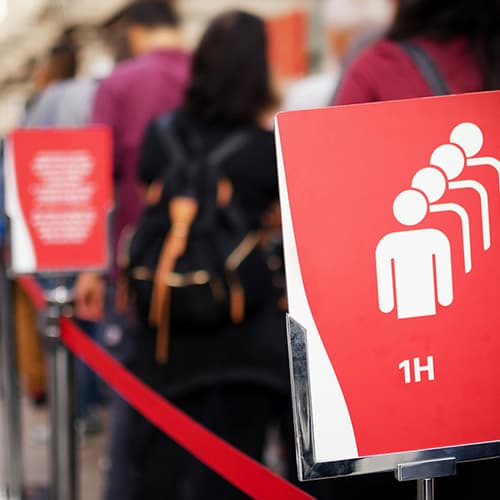
Facility Entrance and Exits
Like parking lot entrances and exits, facility entrance and exit points are a chokepoint for employee foot traffic and thus can be a serious hazard during industrial emergencies like fires, explosions, gas leaks, and other potential accidents and events. Properly trained entrance and exit staff in combination with smart floor design can mitigate safety concerns during evacuation and other heavy traffic events.

Lobbies
Many different kinds of spaces have lobbies, including public venues, hotels, medical facilities, and airports. What most of these spaces have in common is the need for dedicated queue areas, where patrons, customers, and employees safely lineup in areas that allow for plenty of foot traffic flow and safe and fast access to exits. Tools like stanchions are common solutions for organized queues.
Outdoor Spaces
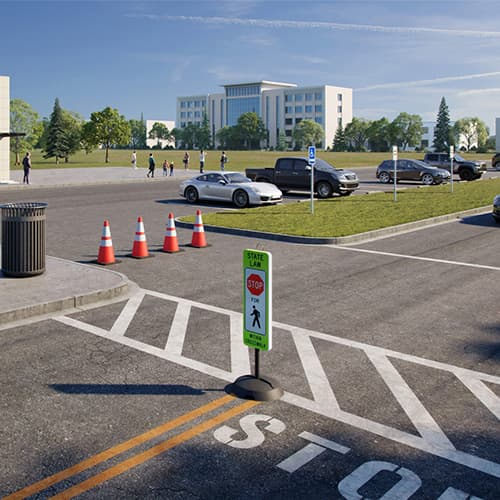
Parking Lots (Vehicles and People)
Parking lots require organized traffic flow to prevent jams, accidents, and congestion. Clearly marked paths for vehicles and pedestrians both are essential elements here.
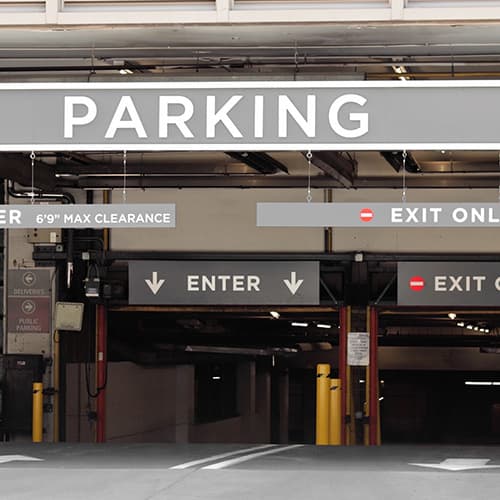
Entrance and Exits To Parking Lots
Entrances and exits to parking lots are focal points of vehicle and pedestrian convergence, so organized management of them is crucial to prevent accidents and ensure smooth flow. Not only for safety, but for ensuring a positive visitor and worker experience instead of a stressful bottleneck situation, which itself can lead to more accidents.
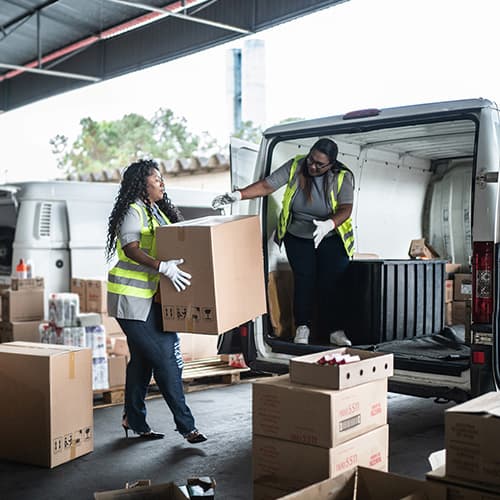
Loading Dock Management
Efficient vehicle management in loading docks is pivotal for maintaining a safe and productive operation, not only preventing accidents but significantly reducing production delays and enhancing overall efficiency.
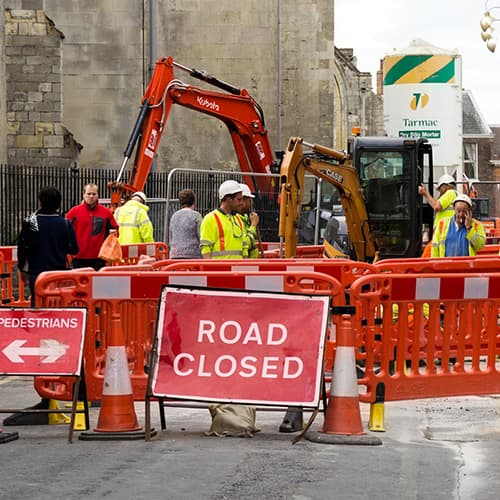
Construction Sites
Construction sites are already dangerous areas, with a combination of vehicles, equipment, dangerous materials, and noise making managing even low foot traffic challenging. Having clearly demarcated walking areas, proper signage, and as much visibility and as little clutter as possible is essential to managing crowds in such areas.
Crowd Management vs. Crowd Control
It’s easy to use the terms “crowd control” and “crowd management” interchangeably, but in the context of safety in venues and industrial work spaces, they’re different terms entirely.
Crowd Management
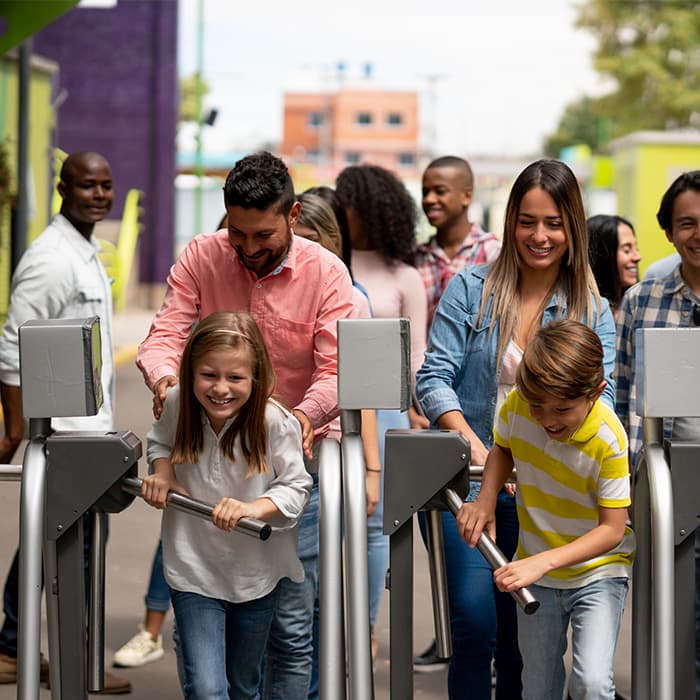
Crowd management refers to the strategy behind crowd control, not the act itself. This includes elements like security staffing and scheduling, floor plan, signage, and even interior design, as well as products like folding security gates, barricades, belt barriers, and safety bollards. The crowd management preparation process can be broken down to several key steps.
Assess Risk
To start with, it’s important to identify the potential safety risks of your space from crowds and heavy foot traffic. Determine general risks such as entrance and exit clearance during crowded events, and further assess any particular areas in your venue or facility that require extra attention— areas where people might gather organically during a performance such as stairs or outside restrooms, for example.
Foot Traffic
As mentioned above, foot traffic is a major concern for every industrial or public space. From construction and manufacturing, where employee foot traffic needs to be organized and optimized, to airports, public venues, and hotels, where patron and customer foot traffic can be light or heavy and is often unpredictable, exits and entrances, walkways, and queue sections must be designed with safety and efficiency in mind.
Vehicle Flow
Determine the traffic your facility or venue will experience daily, whether it be permanent on-site vehicles like carts and construction equipment, employee cars, and visitor traffic.
Equipment
Equipment. Make a thorough list of all the equipment you’ll need in each part of your space before proceeding.
Crowd Control

Crowd control refers to the physical act of controlling, directing, and safeguarding people and equipment in a space. This includes several potential aspects:
Physical Barriers
Physical barriers can be an important part of crowd control in venues such as museums, concert halls, movie theaters, where cordoning off sections for standing and foot traffic is a necessity. Among the many safety and crowd control products available to the hotel industry for example are stanchions, which are pairs of upright bars, posts, or frames that form a barrier, are one of the most common types of physical barriers used in crowd control. They keep crowds from spreading out in areas that need clear points entrance and exit while being movable and modular, and can even add to the aesthetics of a location. Examples are the stanchions that hold up roped-off sections in queues or police procedural tape in crime scenes.
Room divider options, office partition systems, and wall divider panels can also be useful for small spaces like active offices or smaller convention spaces. Barricade systems and road barrier solutions are essential tools for crowd control in outside areas in public events that take place near active roads and streets. Innovative solutions like these mobile barriers with reflective stripes add a lot of flexibility to your arsenal of crowd safety solutions.
Wheel Stops
Wheel stops (also known as parking blocks or wheel chocks) are concrete or rubber barriers that are installed in parking spaces to keep vehicles from rolling too far forward. They’re most often used in parking lots and parking garages so that vehicles are only parked within designated spaces, preventing collisions with both curbs, other vehicles, and equipment.
Traffic, barricade, and safety lights
Traffic, barricade, and safety lights are modular safety lights that can be mounted on barricades, physical barriers, and safety equipment in spaces with vehicle traffic like parking spaces, garages, and construction sites. They are practically essential in construction areas and traffic-heavy spaces with night-time access, but you’ll find them in many places where vehicle and pedestrian safety is an important factor.
Signage and Cones
Traffic control devices like traffic cones and traffic delineator posts are important tools for vehicle crowd control in spaces that require dynamic solutions. Unlike wheel stops and many physical barriers, they’re easily moved and reconfigured to the needs of specific events and projects. Signage is another crucial tool for crowd control that should be considered for any space with crowd control needs, whether they’re permanent or temporary. Items like this Combo LED Emergency Exit Sign offer simple, dynamic solutions for signage.
Audio and Video Equipment
Video equipment like web cameras and security cameras are effective if sometimes costly tools for monitoring people and traffic inside venues, construction sites, and parking areas. Though a small 150-person venue may not need to spend its budget on security cameras, they’re a common feature of parking garages and large construction sites due to their ability to cover a lot of ground, allowing spaces to be monitored by one or two employees instead of several.
Audio equipment could include wall and corner-mounted loudspeakers which can be used for alarms, emergency announcements and changes in procedure or bullet cameras, but can also include hand-held tools like megaphones, which can be especially useful in areas of high crowd density and ambient noise.
Don’t Be Surprised, Be Proactive
There’s no downside to being prepared for everything when it comes to crowd management in your space. Even if you think you’ve considered everything, remember that crowds can easily gather when and where you might not expect them to, which means you have to be able to pivot to the situation. Risk assessment, general planning, hiring, and employee training are all essential elements in crowd management, but making sure you’ve got all the tools you need for any possible situation is an important part of that planning. Having a supply of items like traffic cones, moveable signs, safety lights, and traffic delineators in storage is a good way of making sure you’re never left in the lurch.
The information contained in this article is for informational, educational, and promotional purposes only and is based on information available as of the initial date of publication. It is the reader’s responsibility to ensure compliance with all applicable laws, rules, codes and regulations. If there is any question or doubt in regard to any element contained in this article, please consult a licensed professional. Under no circumstances will Global Industrial® be liable for any loss or damage caused by your reliance on this article.